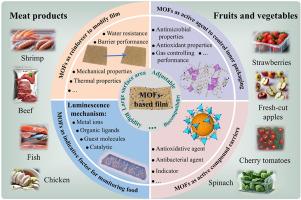Development of multifunctional metal-organic frameworks (MOFs)-based nanofiller materials in food packaging: A comprehensive review
IF 15.1
1区 农林科学
Q1 FOOD SCIENCE & TECHNOLOGY
引用次数: 0
Abstract
Background
Food packaging effectively reduces food postharvest losses, ensures food safety supply, and promotes sustainable development. Metal-organic frameworks (MOFs)-based film materials showed potential in the field of food packaging. Among various nanofillers, MOFs stand out as multifunctional materials characterized by their convenient integration with polymer matrix to develop enhanced, active and intelligent food packaging materials.
Scope and approach
This review initially provided a concise overview of the several synthesis strategies of MOFs and three primary methods for the fabrication of MOFs-based films. Furthermore, the multifaceted functions of MOFs as reinforcers, active agents, and indicative factors in the context of food packaging have also been systematically reviewed. Especially, the functional MOFs-based films for the encapsulation of diverse bioactive compounds applied to delay food spoilage and real-time monitoring of food freshness were discussed. Finally, the toxicological impacts of MOF fillers in food packaging applications were highlighted, encompassing an evaluation of potential risks and the exploration of mitigation strategies.
Key findings and conclusions
The MOFs-based films emerge as promising candidate materials for food packaging applications, as the incorporation of MOFs substantially enhances the mechanical properties, water resistance, and barrier performance of pure biopolymer films. However, traditional food packaging methodologies encounter several challenges, including antibacterial, antioxidant properties, and the effective removal of active molecules. To overcome these limitations, the incorporation of various MOF nanomaterials to enhance the physical and functional attributes of packaging films have been persistently investigated. Therefore, MOFs-based multifunctional film materials could be a viable alternative to develop food packaging.

在食品包装中开发基于金属有机框架(MOFs)的多功能纳米填充材料:综述
背景食品包装可有效减少食品收获后的损失,确保食品安全供应,促进可持续发展。基于金属有机框架(MOFs)的薄膜材料在食品包装领域显示出了潜力。本综述首先简要概述了 MOFs 的几种合成策略以及制造 MOFs 基薄膜的三种主要方法。此外,还系统综述了 MOFs 在食品包装中作为增强剂、活性剂和指示因子的多方面功能。特别是讨论了基于 MOFs 的功能性薄膜可封装多种生物活性化合物,用于延缓食品变质和实时监测食品新鲜度。最后,重点介绍了 MOF 填料在食品包装应用中的毒理学影响,包括对潜在风险的评估和缓解策略的探讨。主要发现和结论基于 MOFs 的薄膜是食品包装应用中大有可为的候选材料,因为 MOFs 的加入大大提高了纯生物聚合物薄膜的机械性能、耐水性和阻隔性能。然而,传统的食品包装方法遇到了一些挑战,包括抗菌性、抗氧化性和有效去除活性分子。为了克服这些限制,人们一直在研究加入各种 MOF 纳米材料来增强包装薄膜的物理和功能属性。因此,基于 MOFs 的多功能薄膜材料可能是开发食品包装的一种可行选择。
本文章由计算机程序翻译,如有差异,请以英文原文为准。
求助全文
约1分钟内获得全文
求助全文
来源期刊

Trends in Food Science & Technology
工程技术-食品科技
CiteScore
32.50
自引率
2.60%
发文量
322
审稿时长
37 days
期刊介绍:
Trends in Food Science & Technology is a prestigious international journal that specializes in peer-reviewed articles covering the latest advancements in technology, food science, and human nutrition. It serves as a bridge between specialized primary journals and general trade magazines, providing readable and scientifically rigorous reviews and commentaries on current research developments and their potential applications in the food industry.
Unlike traditional journals, Trends in Food Science & Technology does not publish original research papers. Instead, it focuses on critical and comprehensive reviews to offer valuable insights for professionals in the field. By bringing together cutting-edge research and industry applications, this journal plays a vital role in disseminating knowledge and facilitating advancements in the food science and technology sector.
 求助内容:
求助内容: 应助结果提醒方式:
应助结果提醒方式:


